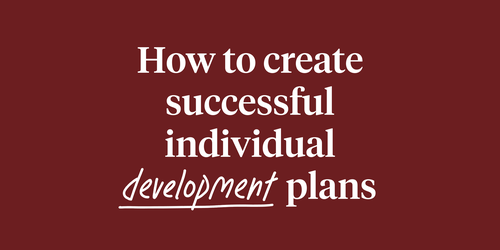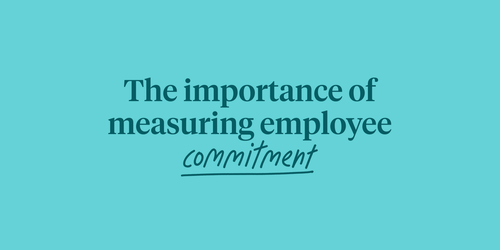
An early honeymoon: How to improve the first-year experience
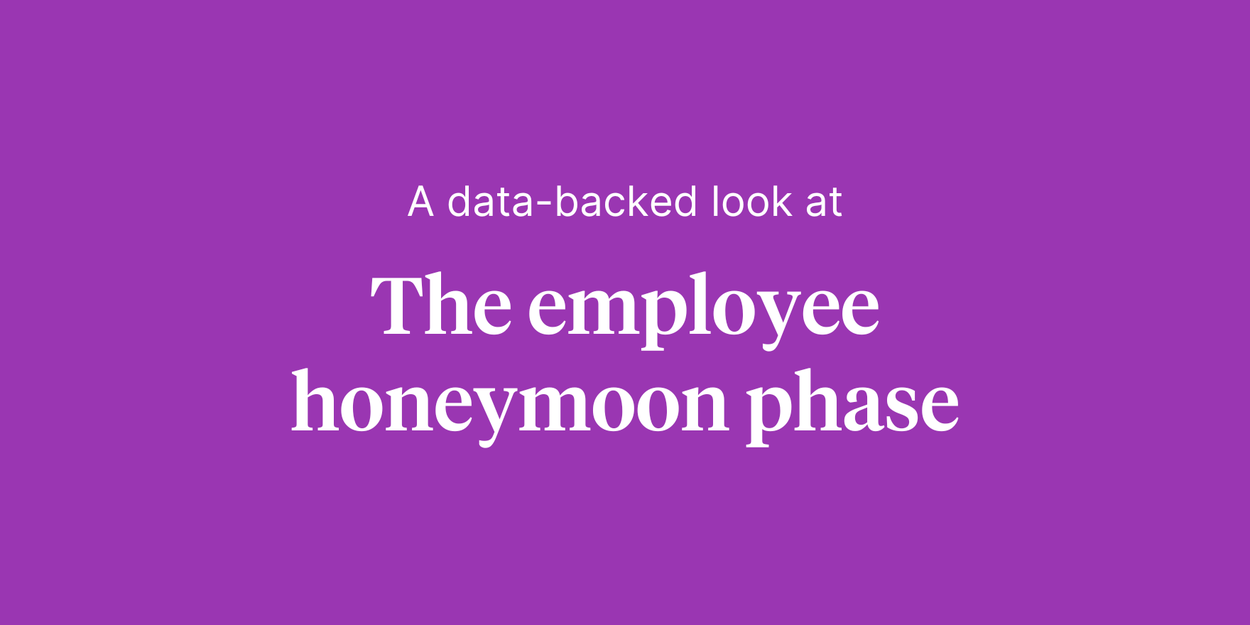
Written by

Senior Data Journalist, Culture Amp
John is nine months into his role at your company. At first, he was bright-eyed and bushy-tailed, buzzing with excitement. Now, he shows up to meetings with less enthusiasm. This could be because of his experience with his role, the people, or your organization’s culture. Whatever the reason, it’s clear that his engagement is on the decline.
What is the employee honeymoon tenure effect?
Unfortunately, John isn’t the only new employee to show these signs. What he’s experiencing is called the honeymoon tenure effect . That’s right – honeymoons aren’t limited to romantic relationships. They occur in organizations, too.
The employee honeymoon phase is marked by high levels of energy (likely matching high expectations for the new experience), followed by subsequent disillusionment as they spend more time at the organization.
You may have experienced the honeymoon effect yourself when joining a new company. While we intuitively agree that it exists, it’s unclear why or how this honeymoon period plays out.
Our methodology
To investigate these questions, we dove into our January - September 2023 global engagement data from 2,901 organizations and 1,762,108 employees. By comparing favorability on key engagement measures across employee tenure, we identified:
- How long the employee honeymoon phase usually lasts
- How organizational commitment drops and increases over time
- Which areas of engagement decline the most after the employee honeymoon phase
- What organizational leaders can do to extend the employee honeymoon phase
What we learned about the employee honeymoon phase
The honeymoon effect can end as early as six months
Employees generally feel high levels of engagement when they join a company, with an overwhelming 91% saying they are proud to work for their organizations and that they would recommend them to others as great places to work. Like many relationships, this early period is smooth sailing.
However, after a mere six to 12 months, employees’ rose-colored glasses start to come off, and employee engagement hits some bumps in the road.
When we looked at data covering the 53 questions in our engagement template, we found that employees who have been at their companies for six to 12 months scored significantly lower (<=4%) on half of those questions compared to those who have been at their companies for less than six months.

While the exact length of the honeymoon varies from employee to employee, it’s clear that employee perceptions of their workplaces start to lose their luster within the first year.
People science insight. In the graph above, you may have noticed that there were improvements for three questions between tenure groups; these questions were all related to taking action on employee survey results.
This makes sense because, after a brief six months, employees are less likely to have seen changes being implemented as a result of their feedback. For a more accurate measurement of employee sentiment around feedback, we recommend asking questions about taking action to only employees who have had the opportunity to experience a full survey cycle.
Engagement turns around after 10 years of tenure
The good news is that it’s not all downhill from there. We find that employees’ overall engagement follows a U-shaped pattern, characterized by:
- A sharp decrease in the first couple of years
- A vertex (lowest point) around four to six years
- A slow increase after 10 years of tenure
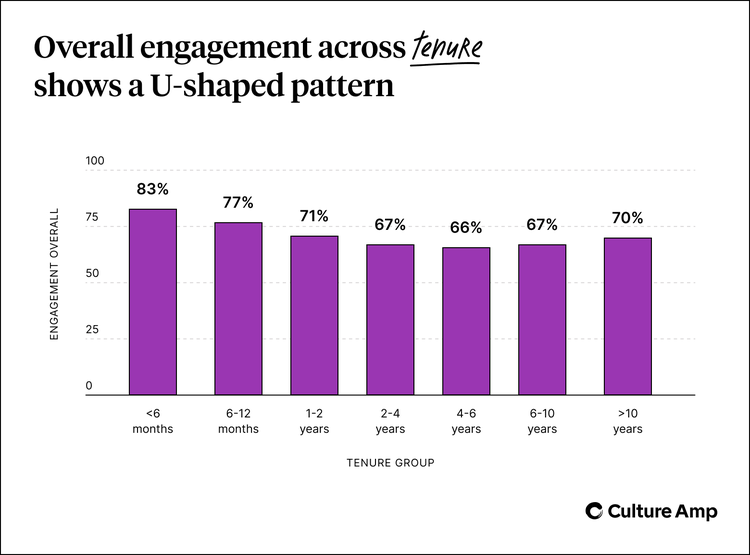
However, even with the improvements that come with tenure, our data indicates that it’s unlikely that engagement will ever reach honeymoon levels again.
As depicted in the above graph, engagement starts around 83% for employees in the < 6 months tenure group, dropping to 66% for employees with 4-6 years of tenure, and then returning to about 70% for employees who have stayed at their companies for more than 10 years.
These findings remain consistent from year to year. When we look at yearly engagement data from 2019 - 2023, we see a similar U-shaped pattern:

NOTE: In 2019 and 2020, engagement dropped to its lowest point at the 2-4 year mark, compared to the past three years (2021 - 2023), when the lowest point was later, between 4-6 years of tenure.
Organizational commitment is the most likely to drop and increase over time
Digging deeper into the five questions that make up overall engagement (“Engagement Index”) in 2023, present commitment (“I rarely think about looking for a job at another company”) and future commitment (“I see myself still working at the company in two years’ time”) are the most likely to show this U-shaped pattern.
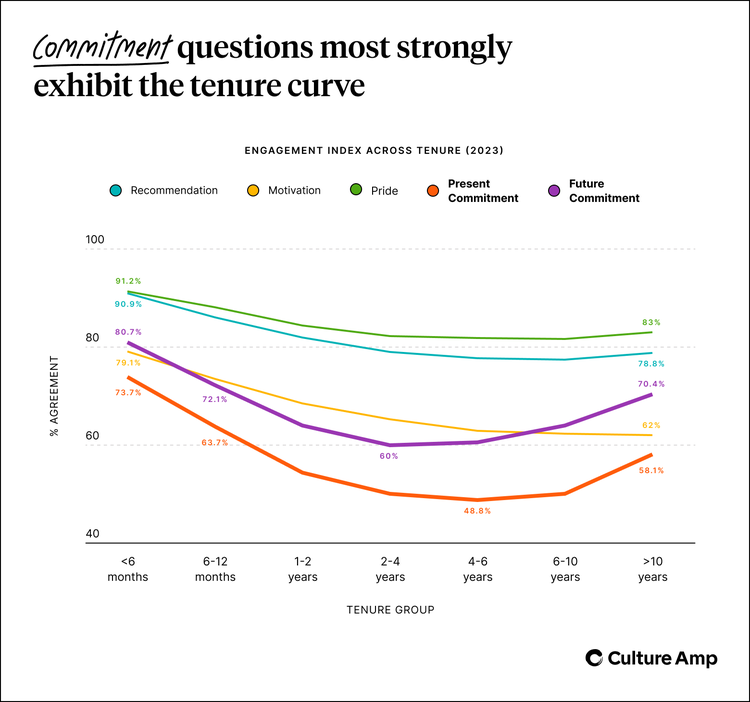
Present commitment. Within the first six to 12 months, employees show a 10% drop in their present commitment – how often they think about going to work elsewhere – from 74% to 64%. Present commitment drops to its lowest point for employees with 4-6 years of tenure (49%), followed by a slight uptick after 10 years of tenure.
Future commitment. Similarly, there is a 9% drop in employees’ future commitment – how likely they are to see themselves staying at their companies for two years – within the first six to 12 months from 81% to 72%. Employees with 2-4 years of tenure report the lowest level of future commitment (60%) before rising again after 10 years.
Overall, we find that while commitment increases with tenure, it never rises above how employees felt in those initial six months. Plus, this uptick likely reflects the fact that those who feel less committed to their organizations will have decided to leave earlier.
Thankfully, this does not have to be the end of the story. Companies have a real opportunity to support employees within that crucial first year to prolong their enthusiasm and increase their commitment to this new (organizational) partner.
What can HR leaders do to extend the honeymoon? 🌴
In addition to drops in organizational commitment, we noticed significant differences between the responses of ~209k employees with a tenure of less than six months and that of ~275k employees with a tenure of six to 12 months. The top three largest declines in employee perceptions within the first year were in:
- Fair compensation
- Availability of good career opportunities
- Open and honest communication at the organization
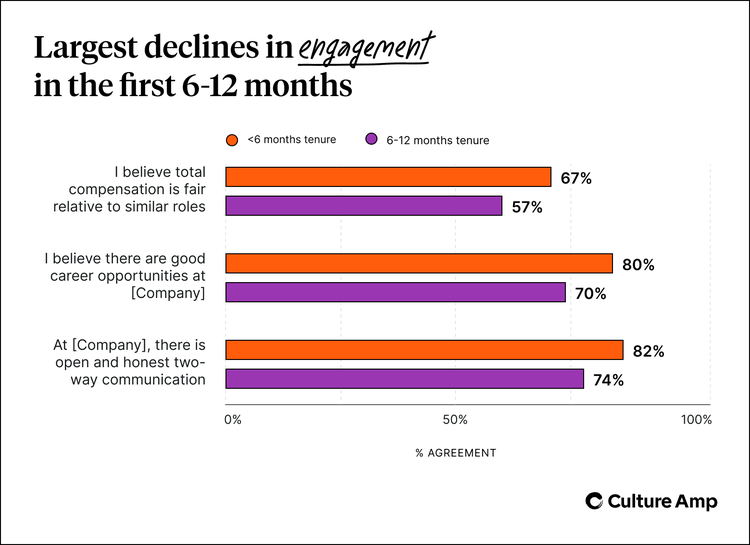
While we can’t say that these declining perceptions are the only reasons the honeymoon period ends, we can confidently say that improving these areas can help prevent a premature “new job hangover.”
In the following section, we’ll walk through each in turn and offer tips for taking action.
Tip 1. Improve perceived fairness of compensation from the get-go 💰
Much like in relationships, employees want to know that they are valued – and total compensation makes up a large part of the employee value proposition (the unique benefits that employers promise to potential talent).
Within the first year, there was a 10% drop in perception of fair total compensation for employees who have been at their organizations between six to 12 months (57%) compared to those who have only been there for less than six months (67%).
To remedy this difference, we suggest that people leaders:
- Conduct pay equity audits. Conducting pay equity audits and sharing this effort with employees can help mitigate any perceived unfairness in pay between new and tenured employees. This is particularly important for HR leaders who are legally required to share pay externally – as is the case for 10 states in the US. That said, we recommend this process for all employers committed to improving workplace equity.
- Share your compensation strategy. By sharing your total compensation strategy (not just pay), you can give employees important context that may be missing when comparing compensation to that of other opportunities. For example, startups that may not be able to match market salaries can offer other benefits like professional development stipends, equity, and flexible work arrangements.
NOTE: Even though we see large declines in perceptions of fair total compensation, our research has consistently found that compensation is not a strong driver of engagement for any tenure group.
Tip 2. Offer ongoing visibility into career opportunities for first-year employees 👀
Crafting an effective onboarding process, creating 30/60/90 day plans, and helping employees settle into their roles are undoubtedly crucial for creating a strong employee experience, but it’s not enough for HR to just “set up” the relationship. HR needs to maintain it by demonstrating a clear commitment to employee development. Like any good relationship, the employee-organization relationship evolves over time. It should never stagnate, and both parties should share an interest in growing together.
While 8 out of 10 employees with a tenure of less than six months believe there are good career opportunities at their organizations, only 7 out of 10 employees who had been at their organizations for six to 12 months believe this to be true (another significant 10% drop within the first year).
To offer continued visibility into career opportunities within the first year and foster a relationship founded on mutual growth, HR and L&D leaders can:
- Encourage managers to have development conversations by at least the first six months. Starting these conversations earlier in the first year allows employees to imagine a future with the organization and start thinking about how they want to grow. Empower your managers with the resources and information they need to guide their direct reports through L&D opportunities from the get-go.
- Start emerging leader programs early in the employee life cycle. If your leadership development programs have a tenure requirement, consider opening up these opportunities earlier. This will help soften the drop in L&D favorability by getting employees excited about learning the skills they need to move into leadership roles.
A lack of employee development opportunities is also a top reason employees decide to leave their organizations, making it all the more important to increase visibility into these opportunities so that you can retain (and energize) talent early on.
Tip 3 - Create and share open communication channels to improve transparency 📣
What is the key to a successful relationship? You’ve heard it a dozen times, but we’ll say it three more times for good measure: communication, communication, and communication. We have yet to see an organizational (or relational) issue that doesn’t benefit from healthy, transparent dialogue.
We found that 82% of employees just starting out in their new companies (less than six months tenure) agree that there is “open and honest two-way communication.” This was 8% greater than those who have been at the company for six to 12 months (74% agreement).
How can organizations improve perceptions of transparency for first-year employees? We recommend that organizations:
- Set up skip-level meetings in the first six months. By meeting with those higher up in the organization at an early stage, employees can have a better and broader understanding of how decisions are made – and have the space to share their feedback on these decisions, too.
- Provide ongoing outlets for upward feedback. This can take the form of more frequent company-wide events where staff can share feedback live with leaders, like an AMA (Ask Me Anything) meeting. Share anonymous feedback outlets with new hires so they know where and how they can get answers to their questions and responses to their feedback.

The honeymoon is only the beginning of the employer-employee relationship
Companies can take action to improve these three core parts of the employee experience that drop significantly in the first year:
- Fair compensation
- Access to career opportunities
- Open communication
By improving perceptions in these three areas, you’ll be able to mitigate the steep drops that happen once the honeymoon phase starts to fade.
However, while these are the areas that we found to need the most attention globally across companies, we recommend that HR leaders track engagement by tenure in order to identify their own unique opportunities to maintain a positive employee experience in the first year.
This way, once employees hit their one-year mark, they’ll be able to reflect on the last year with contentment, committed to making the relationship work out. Happily engaged.



